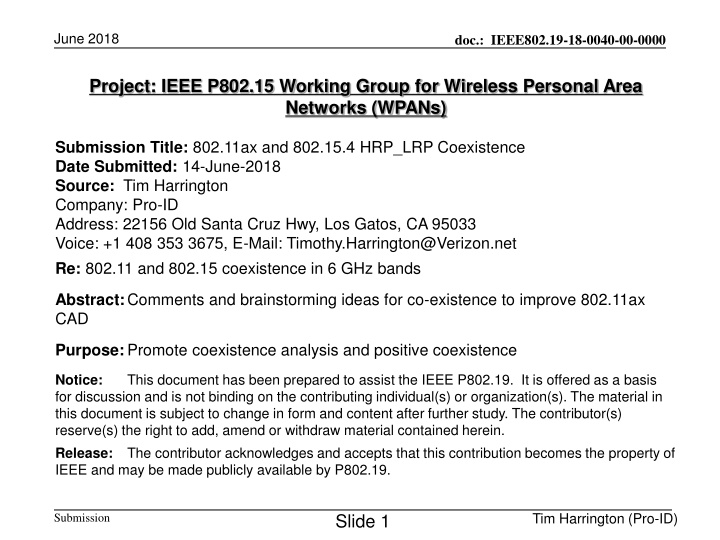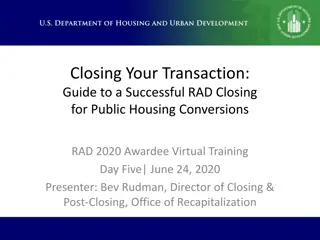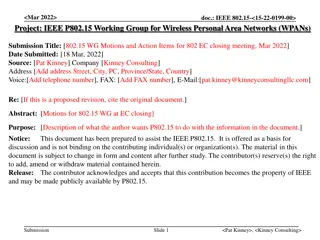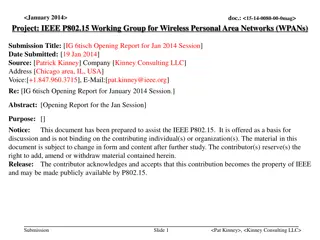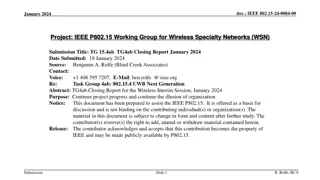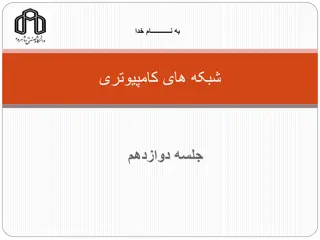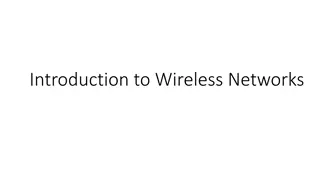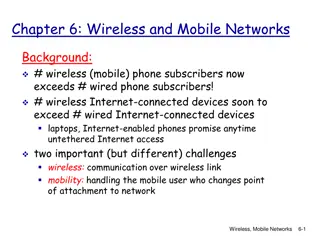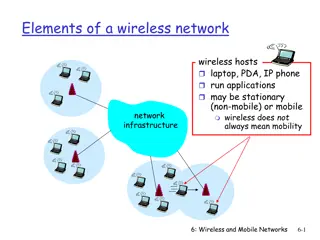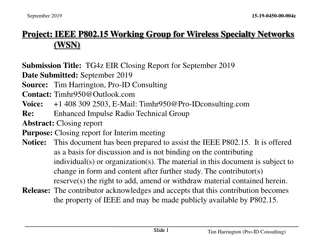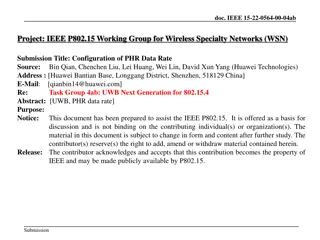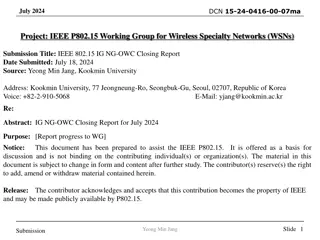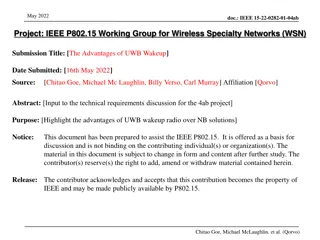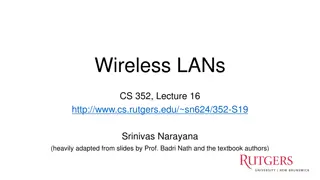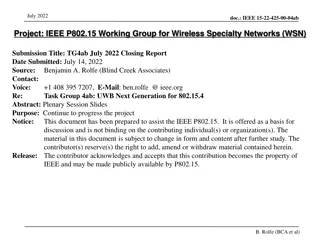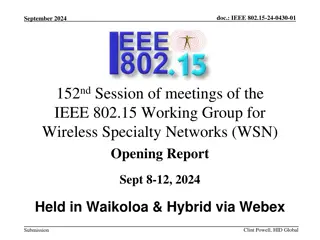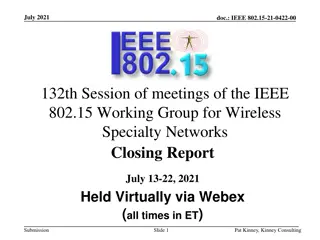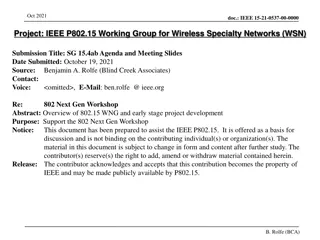IEEE P802.15 Wireless Specialty Networks Closing Report - January 2020
This document is the closing report for the IEEE P802.15 Working Group meeting held in January 2020. It includes accomplishments, motions, timeline updates, and details on the formation of a Comment Resolution Group (CRG) for the P802.15.4z standard. The report outlines the progress made and the next steps in the development process.
Uploaded on Apr 26, 2025 | 2 Views
Download Presentation

Please find below an Image/Link to download the presentation.
The content on the website is provided AS IS for your information and personal use only. It may not be sold, licensed, or shared on other websites without obtaining consent from the author.If you encounter any issues during the download, it is possible that the publisher has removed the file from their server.
You are allowed to download the files provided on this website for personal or commercial use, subject to the condition that they are used lawfully. All files are the property of their respective owners.
The content on the website is provided AS IS for your information and personal use only. It may not be sold, licensed, or shared on other websites without obtaining consent from the author.
E N D
Presentation Transcript
June 2018 doc.: IEEE802.19-18-0040-00-0000 Project: IEEE P802.15 Working Group for Wireless Personal Area Networks (WPANs) Submission Title: 802.11ax and 802.15.4 HRP_LRP Coexistence Date Submitted: 14-June-2018 Source: Tim Harrington Company: Pro-ID Address: 22156 Old Santa Cruz Hwy, Los Gatos, CA 95033 Voice: +1 408 353 3675, E-Mail: Timothy.Harrington@Verizon.net Re: 802.11 and 802.15 coexistence in 6 GHz bands Abstract: Comments and brainstorming ideas for co-existence to improve 802.11ax CAD Purpose: Promote coexistence analysis and positive coexistence Notice: for discussion and is not binding on the contributing individual(s) or organization(s). The material in this document is subject to change in form and content after further study. The contributor(s) reserve(s) the right to add, amend or withdraw material contained herein. Release: The contributor acknowledges and accepts that this contribution becomes the property of IEEE and may be made publicly available by P802.19. This document has been prepared to assist the IEEE P802.19. It is offered as a basis Tim Harrington (Pro-ID) Slide 1 Submission
June 2018 doc.: IEEE802.19-18-0040-00-0000 Part 1: Review of doc IEEE 802.11-16/1348r3 TGax Coexistence Assurance Document and Brainstorming Ideas from May 2018 Wireless Interim Tim Harrington (Pro-ID) Slide 2 Submission
June 2018 doc.: IEEE802.19-18-0040-00-0000 Summary 802.11ax scope has been changed to include use of the 6 GHz band Systems based on 802.15.4 UWB PHYs are widely used in the 6 GHz band Task Group 15.4z has reviewed the CAD and provides comments and suggestions to help improve the11ax TG CAD so that there is better understanding of the coexistence characteristics Tim Harrington (Pro-ID) Slide 3 Submission
June 2018 doc.: IEEE802.19-18-0040-00-0000 3 Coexistence with non-802.11 systems IEEE 802.15.4 HRP UWB and LRP UWB PHYs operate in the 6 GHz band. Coexistence has not been characterized or analyzed with respect to 802.15.4 HRP UWB and LRP UWB which use Impulse Radio (IR) modulation. With reference to CCA/CSMA as a coexistence mechanism, does the current anticipated CCA/CSMA mechanism able to detect 802.15.4 UWB signals for bands above 6 GHz; How does this affect coexistence with 802.15.4 UWB based systems? An assessment of the impacts on 802.15.4 UWB based on the different 802.11ax channelization options would be helpful. It would be helpful to provide analysis of 802.11ax with respect to the 802.15.4 UWB systems as both victim and assailant. This has not been done in a prior 802.11 CAD We are aware that there has been extensive consideration of coexistence between 802.11 and 3GPP LAA systems. As this is relevant to the coexistence of 802.11ax. It would be helpful to mention it and provide a reference. Tim Harrington (Pro-ID) Slide 4 Submission
June 2018 doc.: IEEE802.19-18-0040-00-0000 5.2 Spatial Reuse Compare 11ax noise floor to the noise floor of HRP UWB and LRP UWB at different distances, different channel widths. Tim Harrington (Pro-ID) Slide 5 Submission
June 2018 doc.: IEEE802.19-18-0040-00-0000 5.6 Operation in the 6 GHz Band An analysis of Packet error rate for 802.11ax, and frame error rate or bit rate for LRP and HRP when used within a representative set of operational ranges would be useful. Analysis of the effects of 802.11ax CSMA on UWB: How will CSMA hear HRP and LRP pulses? How will the different bandwidth options affect UWB devices? What are the effects at similar center frequencies, and at different frequencies for LRP UWB, HRP UWB, and 802.11ax?. What happens at the extremes? Tim Harrington (Pro-ID) Slide 6 Submission
June 2018 doc.: IEEE802.19-18-0040-00-0000 Part 2: Brainstorming Ideas from May 2018 Wireless Interim Tim Harrington (Pro-ID) Slide 7 Submission
June 2018 doc.: IEEE802.19-18-0040-00-0000 Coexistence Brainstorming Can 802.11ax and LAA use the same power levels as UWB? ??? Can 802.11ax LAA use adaptive power control Sense UWB and restrict power? Raise UWB power level to match 802.11ax and LAA Not desirable because it will shorten battery life, but could be a solution if we jointly petitioned FCC and ECC Duty cycle for 802.11 and LAA? Could there be a predictable duty cycle on a local basis? What about 3GPP LAA in the 6 GHz band Does 802.11ax anticipate the arrival of 3GPP LAA Tim Harrington (Pro-ID) Submission Slide 8
June 2018 doc.: IEEE802.19-18-0040-00-0000 Coexistence Brainstorming UWB scan receiver that looks for interference, and then go to a different channel Too costly for UWB RTLS tags Coexistence control channel interface for scheduling Too costly for UWB RTLS tags Send signal to trigger CSMA to cause 802.11ax and 3GPP LAA to back off Possible if these devices can be made to sense pulses WGFM appears to be restricting 6 GHz broadband to less than 6.4125 GHz in the EU. If this were extended to 6.3 GHz, then 802.11ax would have 340 MHz of new bandwidth, and UWB centered at 6.55 GHz would have a clear channel Is this a possibility for 802.11ax? Tim Harrington (Pro-ID) Submission Slide 9
